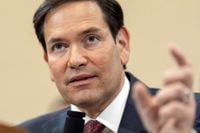On Friday, July 11, 2025, the U.S. State Department began laying off more than 1,300 employees as part of the Trump administration’s sweeping plan to downsize the federal government and reduce bureaucratic bloat. This move, described by Secretary of State Marco Rubio as the department’s largest reorganization in decades, marks a significant shift in American diplomacy and has sparked sharp criticism from diplomats and lawmakers alike.
According to internal notices obtained by multiple news outlets, the layoffs affect 1,107 civil service employees and 246 Foreign Service officers based in the United States. Foreign Service officers will be separated from the department 120 days after receiving their reduction-in-force (RIF) notices, during which they will be placed on administrative leave. Civil service employees generally face a 60-day separation period. The department has also seen approximately 1,600 employees voluntarily depart under deferred resignation programs, bringing the total expected departures to nearly 3,000—about 15% of the State Department’s workforce.
Deputy Secretary of State for Management and Resources Michael Rigas sent an email to the workforce on Thursday evening, July 10, acknowledging the upcoming notifications. He described the layoffs as part of a “targeted reduction” designed to eliminate redundant offices and focus resources on core policy priorities. “First and foremost, we want to thank them for their dedication and service to the United States,” Rigas wrote, emphasizing the department’s intent to empower its people while increasing accountability.
Secretary Rubio, speaking from Kuala Lumpur, Malaysia, where he attended the Association of Southeast Asian Nations Regional Forum, defended the reorganization as a “very deliberate step” to make the State Department more efficient and focused. “It’s not a consequence of trying to get rid of people. But if you close the bureau, you don’t need those positions,” Rubio explained. He noted that many cuts involve eliminating positions rather than people, including unfilled roles or those vacated through early retirement.
The reorganization plan, first announced in April 2025, proposes an 18% reduction of the domestic workforce—higher than the 15% initially floated—and entails the elimination or consolidation of more than 300 bureaus and offices. The department plans to cut divisions overseeing America’s two-decade involvement in Afghanistan, including an office dedicated to resettling Afghan nationals who worked alongside U.S. forces. Programs related to refugees, immigration, human rights, and democracy promotion are also targeted for elimination.
However, the plan was temporarily stalled in May when a federal judge blocked the layoffs, citing concerns over the administration’s failure to consult with Congress. This legal hurdle was cleared on July 8, 2025, when the Supreme Court overturned the lower-court injunction, allowing the Trump administration to proceed with layoffs across 19 federal agencies, including the State Department. The ongoing lawsuits challenging the legality of these cuts have not yet been resolved, but the Supreme Court’s ruling effectively paved the way for the reorganization to move forward.
Despite the administration’s insistence on efficiency, the layoffs have drawn fierce criticism from the American Foreign Service Association (AFSA), the union representing diplomats. AFSA estimates that the Foreign Service has already lost at least 20% of its workforce this year through forced resignations and shuttered institutions. The union warns that these layoffs, which it describes as “untethered from merit or mission,” threaten to degrade U.S. diplomatic capacity at a critical global moment.
“Losing more diplomatic expertise at this critical global moment is a catastrophic blow to our national interests,” AFSA President Tom Yazdgerdi said. He urged the department to view reduction-in-force notices as a last resort, warning that disrupting the Foreign Service risks undermining America’s global influence and the ability to carry out vital missions abroad.
Democrats on the Senate Foreign Relations Committee echoed these concerns. Led by Senator Jeanne Shaheen of New Hampshire, they criticized the layoffs as “blanket and indiscriminate cuts” that jeopardize national security amid active conflicts and humanitarian crises in Ukraine, Sudan, Gaza, Haiti, and Myanmar. “Now is the time to strengthen our diplomatic hand, not weaken it,” the committee stated.
Morale within the State Department has suffered amid the uncertainty and upheaval. Employees were instructed on Thursday to report to work with all department-issued equipment, including laptops, phones, and diplomatic passports, as signs directing staff to “Badge Turn-In” and “transition day out processing” appeared throughout the building. One civil servant told NBC News that the prolonged limbo was emotionally taxing: “Every Friday morning, I wake up with dread. At least now we can move on.” Another employee, speaking anonymously to The Washington Post, lamented that leadership “either doesn’t appreciate or just doesn’t care” about the workforce, especially as many staff were simultaneously working extra hours to assist U.S. citizens fleeing the Middle East amid escalating tensions in the region.
Former career diplomats have expressed alarm over the loss of institutional knowledge and expertise that these cuts entail. Robert E. Hunter, a former U.S. ambassador to NATO, warned that the department “will not have sufficient talent, experience and proper organization needed for U.S. foreign policy to prosper in the years ahead, or even for State to be able to provide critical help sometimes needed by Americans abroad.”
Adding to the department’s challenges is a federal hiring freeze that remains in place, limiting its ability to recruit and retain new talent. A senior official indicated that the department is reviewing recruitment and retention strategies as part of an executive order, but acknowledged the constraints imposed by budget ceilings. In 2024, the State Department reportedly hit its salary funding ceiling for the domestic workforce, preventing new hires and contributing to the pressure for cuts.
Secretary Rubio has framed the reorganization as a necessary modernization effort. In an April 22 statement, he described the department as “bloated, bureaucratic, and unable to perform its essential diplomatic mission in this new era of great power competition.” He promised a new model that would bring the State Department into the 21st century, provide taxpayers a better return on investment, and “make the State Department Great Again.”
Rubio detailed plans to consolidate region-specific functions, remove redundant offices, and eliminate non-statutory programs misaligned with America’s core national interests. State Department spokeswoman Tammy Bruce echoed this vision, saying the department is entering the “implementation” phase of its reorganization and aims to operate “in a manner that makes it relevant and effective.”
For now, there are no announced plans to close additional U.S. embassies or consulates, though the department continues to review its overseas missions. “We don’t have any plans for that right now, but I think just good practice means a constant review and evaluation of how we’re doing our job,” a senior official said.
As the State Department embarks on this unprecedented restructuring, the tension between efficiency and capability remains at the forefront. The administration’s drive to streamline a sprawling bureaucracy clashes with concerns about weakening America’s diplomatic reach at a time of global uncertainty. Whether the department can balance these competing demands will shape U.S. foreign policy and its standing in the world for years to come.





